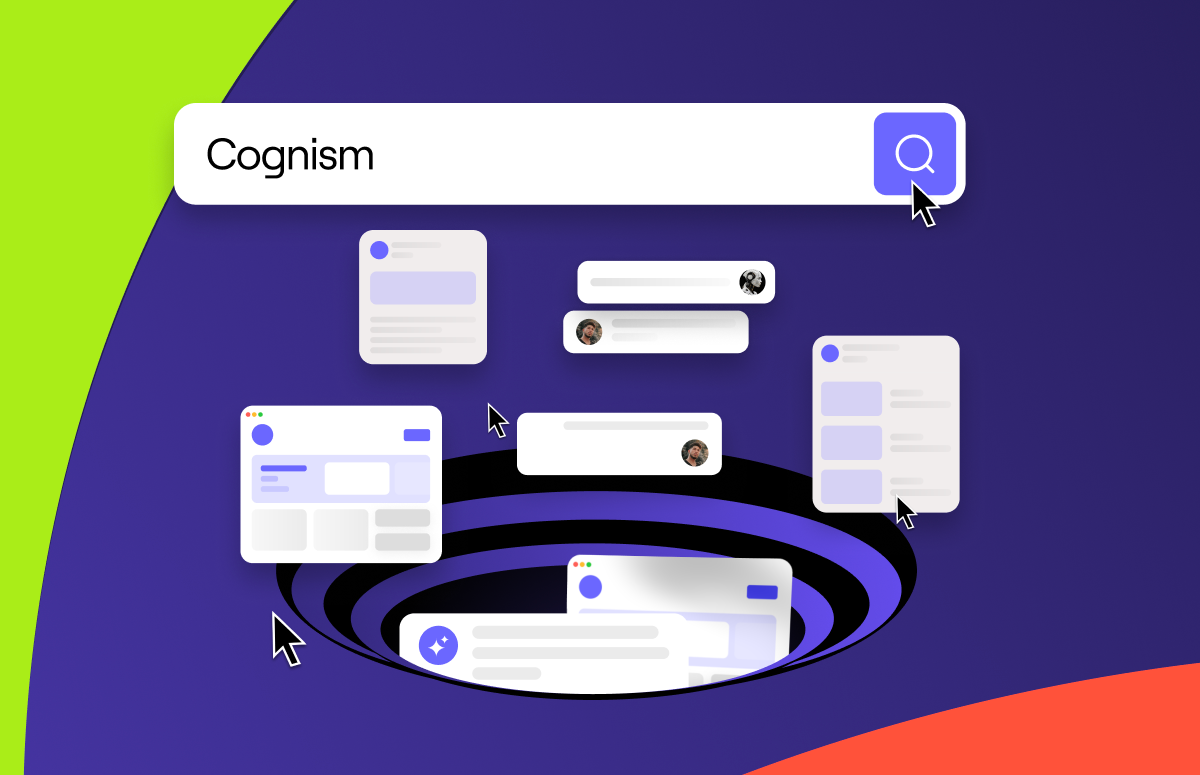Marketing Pipeline: Crafting a Strategy to Drive Revenue
Marketing pipeline resources on this page:
Do you want to optimise your marketing pipeline and unlock opportunities in new areas?
Recently, the Cognism team faced a new challenge: switching from a ‘growth at all costs’ mentality to an ‘optimise efficiency’ mindset.
In doing this, we uncovered several new tactics for powering marketing generated pipelines. Now, we’re sharing them with you.
So scroll on to unlock the secrets of the ultimate marketing pipeline strategy 👇
What is a pipeline in marketing?
Pipeline marketing generates leads and increases revenue by focusing on the entire sales funnel. It involves using different channels and campaigns to engage customers and expand the funnel.
Think of it as navigating through a series of levels in Super Mario. Your objective is to guide leads from the beginning of the pipeline to the final level, where they become loyal customers.
Pipeline marketing isn’t just about filling the pipeline with leads - it’s about nurturing those leads through each stage, ensuring they don’t fall into lava pits or get gobbled up by Piranha Plants. It’s about creating targeted content, personalised campaigns, and strategic follow-ups that keep your prospects moving forward.
Instead of treating marketing and sales as separate entities, pipeline marketing integrates them into a seamless continuum. It focuses on driving revenue rather than just generating leads and provides a straightforward, structured approach to managing leads from initial interest to final sale.
Marketers can identify bottlenecks by focusing on each pipeline stage, optimise conversion rates, and drive more revenue. It’s like having a detailed map of the marketing kingdom, with each stage carefully planned out to ensure you reach the end of the game efficiently and effectively.
The 6 marketing pipeline stages
Every stage of the marketing pipeline has unique challenges and objectives. Let’s explore how each stage plays a crucial role in driving revenue 👇
1. Lead generation
This is the start of your pipeline adventure, and your goal is to attract as many potential customers as possible.
At this stage, you want to grab the attention of new prospects so they know that you exist.
It’s the icebreaker.
Content marketing, social media, SEO, and paid ads can help achieve this.
Think of this as Mario’s initial foray into a new level, where he collects as many coins and power-ups as possible.
For example:
Suppose you’re a B2B SaaS company. You might use an eBook on industry trends to attract potential leads, promoting it through LinkedIn ads and blog posts. Each download or form submission brings a new lead into your pipeline, ready to be nurtured.
2. Lead nurturing
In the next stage of your content marketing pipeline, your goal is to build relationships and maintain engagement.
Once you’ve captured leads, you’ll need to nurture them.
This involves providing relevant and valuable content to your prospects over time, ensuring they remain engaged and interested in your product or service. This stage is all about creating a connection and building trust.
For example, using email marketing automation, you could send a cadence of personalised emails offering case studies, how-to guides, and webinars.
You’ll want to design each touchpoint to educate your prospects, keep them engaged, and move them closer to a purchasing decision.
3. Lead qualification
The following stage involves identifying which leads have the highest potential.
Lead qualification is where you determine which leads are ready for a more serious conversation.
This involves evaluating leads based on criteria such as budget, authority, need, and timeline (BANT). Qualified leads are those who show strong potential to become customers.
For example, implementing a lead scoring system in your CRM can help.
You might score leads based on their interactions with your content, company size, and buying readiness. Your sales team will then take on high-scoring leads for further engagement.
4. Demo
You’ve now reached the stage of the marketing pipeline where you can showcase your product’s value in more detail.
In the demo stage, you’ll showcase your product’s capabilities.
This is your chance to directly address your prospect’s pain points and demonstrate how your solution can help. A practical demo can significantly boost the likelihood of closing a deal.
For example, conducting a live sales demo over a video call lets you walk your prospect through your software’s key features and benefits.
Tailoring the demo to address specific needs and questions raised during the lead nurturing stage can make a powerful impact.
5. Closing
You’ve reached the end and now face the final boss time: you have to close the sale.
This stage involves final negotiations, addressing any remaining concerns, and securing the sale.
It’s critical to handle this stage carefully; you must provide clear, compelling reasons for the prospect to choose you.
For example:
Your sales team might offer a special discount, flexible payment terms, or an additional feature to close the deal.
Ensuring the contract and terms of the deal are straightforward and transparent will also help seal it with confidence.
6. Post sale
You might think you’ve finished. Deal done. Game over.
We’ve got news for you: there’s still a secret stage to complete. The one where you ensure your customer is onboarded, satisfied, and becomes loyal to you.
The post-sale stage is about ensuring your new customers are happy and well-supported.
This includes onboarding, providing exceptional customer service, and seeking feedback to improve your offerings. Happy customers are more likely to become repeat buyers and brand advocates.
For example:
After closing the sale, your customer success team might provide a detailed onboarding program, regular check-ins, and access to a knowledge base and support services.
Encouraging customers to share their experiences and testimonials can also help attract new leads, feeding back into the lead generation stage.
By understanding and optimising each stage, you can create a seamless and effective marketing sourced pipeline that guides leads from initial interest to loyal customers, driving consistent revenue growth.
Think of each stage as a new level requiring specific strategies and tools to conquer and advance to the next.
Cognism’s marketing pipeline strategy
In B2B marketing, strategies must adapt to changing economic climates and evolving business needs.
For the team at Cognism, this meant embarking on a quest to change our approach.
Cognism’s strategy shift
At the end of 2022, the Cognism leadership faced a turning point.
The economy took a sharp turn, prompting a shift from sheer revenue growth to the quality and retention of incoming business.
Our mindset changed from ‘growth at all costs’ to ‘optimise efficiency’.
This transformation led to innovative tactics that streamlined our processes and unlocked new opportunities for our marketing sales pipeline.
Alice de Courcy, Cognism’s CMO, reflected on this shift:
“While reviewing the metrics, we discovered that many businesses marketing brought in had fairly low retention rates. They were more of what we’d call an ‘automate’ or ‘velocity’ type business.”
“We were able to hit our revenue number with these accounts. But looking at long-term ROI for the business, we realised that this could be better.”
Our B2B marketing strategy pivoted towards a new goal: replicating growth and success but focusing on attracting long-term partners like enterprises and growth+ businesses.
Understanding Cognism customer segments
Segmenting our customers helped us navigate the vast marketing landscape. We uncovered that the size of our customers’ sales teams correlated with higher Average Contract Values (ACV) and better retention rates.
Armed with this knowledge, we refined our approach to attract the ideal high-value customers while still providing value to all segments and improving solutions for smaller, automate/velocity customers.
We decided on a ratio of LTV to CAC of 3:1.
Here’s a quick breakdown of what we mean by each term:

How we optimised our channels
Just as Mario uses different tactics depending on which level he finds himself in, we optimised our approach on various channels to reach our B2B target audiences effectively.
We faced challenges with Facebook’s limited audience and high-frequency rates, repeatedly showing the same ads to the same people.
We expanded our audience by switching our objective to conversion and leveraging metadata while maintaining relevance.
Using this approach, a 5% increase in spending led to an incredible 500% increase in our sales and marketing pipeline.
Here’s a summary of how we did it:
We refined our LinkedIn marketing strategy to increase impression share for our most valuable accounts.
Exclusions became our star power-ups, allowing us to focus our reach and refine our audience.
The result?
A 26% growth in our growth+ pipeline and a 43% increase in engagement rates on our ads.
As Alice said:
“I’d highly recommend paying attention to audience insights. It should be your best friend on LinkedIn.”
“Because you might think, ‘Oh yeah, I’m covered - all these companies within these parameters are seeing my ads.’ But when you start to deep dive, you might see that some companies are taking up a massive portion of the market, and you might want to exclude them.”
“Maybe they’re just too large for your organisation right now, or perhaps it doesn’t make sense to be spending that much money on, say, the Salesforces of the world.”
Google Ads
With Google Ads’ intent-based nature, some might say there’s not much you can do to influence it.
However, we decided to be more meticulous and break our competitor campaigns down to have control over each specific keyword.
Our first port of call was to look at each campaign to find out:
- Where our spend was going.
- The conversions that our campaigns created.
- And most importantly, the type of pipeline they created.
This way, we could compare the performance of competitor keywords such as ‘Lusha alternative’ and ‘ZoomInfo pricing’.
So far, we’ve seen improvements in our Google Ads every quarter.
YouTube
Venturing into YouTube, a relatively new channel for us, we targeted competitor keywords and leveraged audience data.
Similar to how we looked at Google as an intent-based channel, we focused on searches for companies we know also target an enterprise audience and used Cognism data to create matched audiences.
Our carefully crafted content and targeting techniques led to an average watch time triple that of industry benchmarks.
SEO
We previously ran a traditional SEO strategy but realised that while it generated high traffic volumes, the action level from these was low.
So, we changed our approach to focusing on high-intent and long-tail keywords to increase conversions and the quality of our traffic.
This ‘money keywords’ strategy was successful! It yielded a record-high number of conversions for us and a surge in organic traffic value.
Liam Bartholomew, VP of Marketing at Cognism, said:
“Another great thing about this strategy is it gets you to think beyond just the SEO side of things. Instead, you look at other ways to improve pages for conversion.”
“We’d look at page style, ensuring we deliver the value or answers the person searching for this term would be looking for immediately. We’d review CTA placement and whether the text and direction for them made sense.”
“Ultimately, anything that means you’re better serving the prospect coming through.”
Creating a better customer journey
In our quest for growth and focus on enterprise customers, we didn’t want to forget about our loyal supporters, especially those with two or fewer sales reps.
So, we optimised our customer routing and retention strategies to ensure a seamless experience for all, from solo adventurers to large enterprises.
This included reviewing our pricing structure to make it more viable for smaller companies.
As we continue our journey through the SaaS marketing realm, we’ll apply Mario’s resilience and adaptability to overcome new challenges, confident that our pipeline marketing strategies are as robust as possible.
Marketing pipeline: key takeaways
Just like Mario and his friends conquer new worlds and face epic challenges, your journey through pipeline marketing requires adaptability, strategic thinking, and a clear vision.
By understanding and optimising each stage of the marketing data pipeline - from lead generation and nurturing to qualification, demo, closing, and post-sale - you can drive consistent revenue growth and build lasting customer relationships.
Embrace the strategic shifts, learn from each channel’s nuances, and always aim to refine your approach. Remember, every tweak and optimisation is a step closer to marketing success.
Add Cognism to your pipeline marketing tech stack
Connect with in-market companies globally with Cognism.
Our B2B data is GDPR and CCPA-compliant, with the option to verify contact data on demand.
With unbeatable European data and the widest coverage of mobile numbers globally, you can generate leads for your campaigns and sales team in minutes - powering your marketing pipeline to new heights.
Click the banner to speak to a data expert about your goals today 👇



